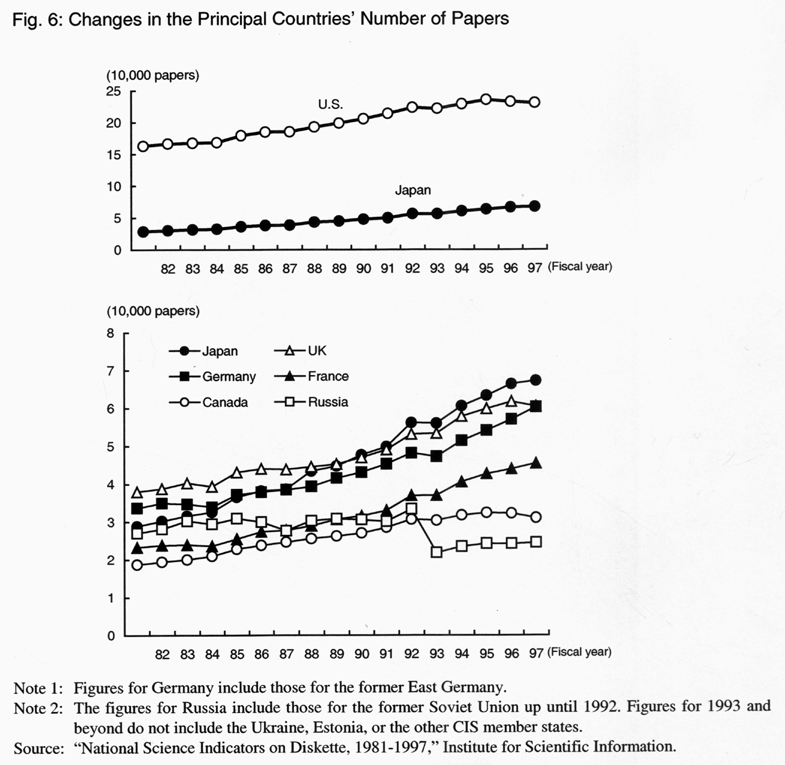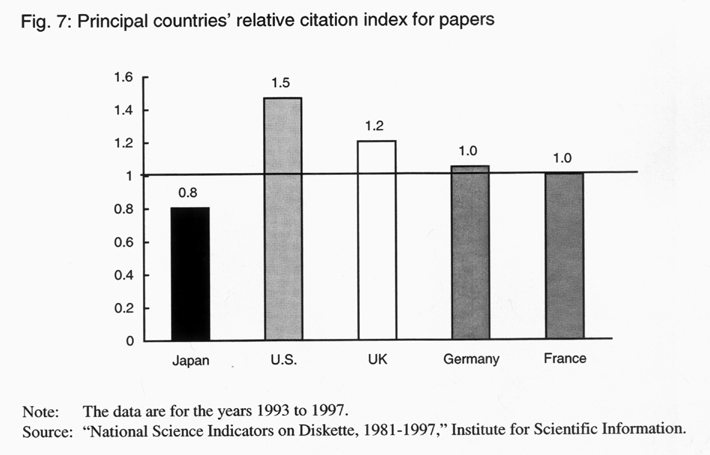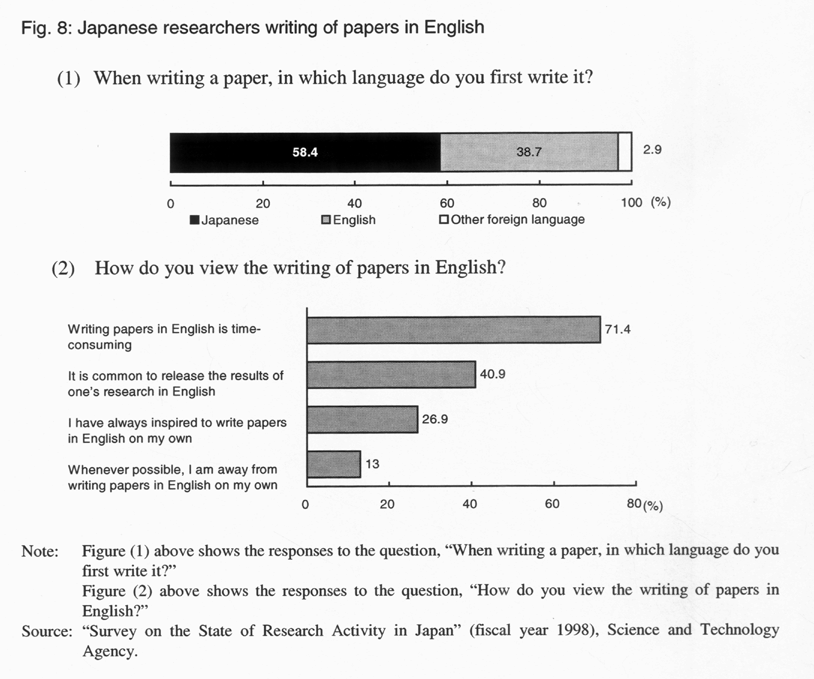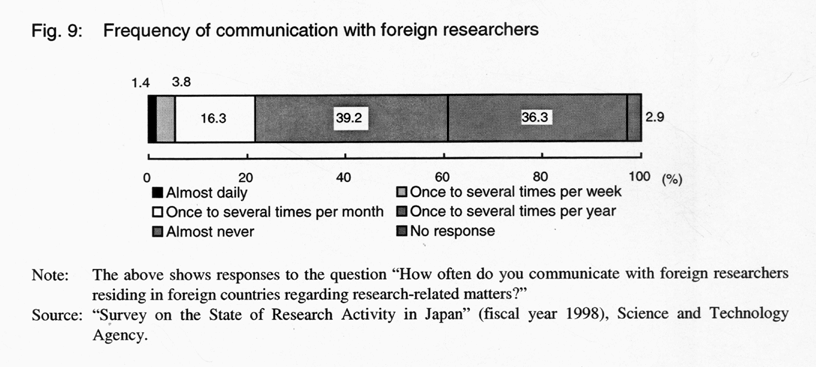| Home > Policy > White Paper, Notice, Announcement > White Paper > Annual Report on the Promotion of Science and Technology 1999 > Part1 Chapter2 Section2 1 | ||
![]() Although not a sufficient basis for sweeping generalizations,
numbers of papers and citations are used here to assess the level of basic research
in Japan.
Although not a sufficient basis for sweeping generalizations,
numbers of papers and citations are used here to assess the level of basic research
in Japan.
Two main conclusions can be drawn from this assessment.
| (Number of Papers) |
![]() According to the NSI (National Science Indicators) database
of the Institute of Scientific Information in the United States, Japan ranked
4th in the world in number of papers in 1981 but 2nd in 1997. This approximately
2.3-fold increase in the number of papers was the highest of the advanced nations
(Japan, the U.S., the UK, Germany and France) in that period ( Fig.
6 ).
According to the NSI (National Science Indicators) database
of the Institute of Scientific Information in the United States, Japan ranked
4th in the world in number of papers in 1981 but 2nd in 1997. This approximately
2.3-fold increase in the number of papers was the highest of the advanced nations
(Japan, the U.S., the UK, Germany and France) in that period ( Fig.
6 ).

| (Number of Citations) |
![]() Given that excellent papers are cited frequently in other
papers, the number of papers cited is an indicator of the quality of those papers.
The percentage of Japanese papers cited in other papers increased constantly
from 5.5% in 1981 to 7.8% in 1997.
Given that excellent papers are cited frequently in other
papers, the number of papers cited is an indicator of the quality of those papers.
The percentage of Japanese papers cited in other papers increased constantly
from 5.5% in 1981 to 7.8% in 1997.
![]() As for the figure indicating how the average citations per
paper compare with the international average (relative citation), in which the
international average is assigned an arbitrary value of 1, Japan shows a relative
citation of 0.8. The top countries are the U.S., UK, Germany and France ( Fig.
7 ).
As for the figure indicating how the average citations per
paper compare with the international average (relative citation), in which the
international average is assigned an arbitrary value of 1, Japan shows a relative
citation of 0.8. The top countries are the U.S., UK, Germany and France ( Fig.
7 ).

| (The Level of Japan's Basic Research) |
![]() The above data suggest that further efforts for qualitative
improvement in Japan's basic research are required.
The above data suggest that further efforts for qualitative
improvement in Japan's basic research are required.
![]() On the level of individual researches, however, there can
be found many researches of internationally high recognition, such as research
on neutrino mass measurement using Super-Kamiokande, a large-scale water cosmic
ray and elementary particle detector at the Institute for Cosmic Ray Research,
University of Tokyo, located in Kamioka Town, Gifu Prefecture.
On the level of individual researches, however, there can
be found many researches of internationally high recognition, such as research
on neutrino mass measurement using Super-Kamiokande, a large-scale water cosmic
ray and elementary particle detector at the Institute for Cosmic Ray Research,
University of Tokyo, located in Kamioka Town, Gifu Prefecture.
![]() What is important is to take on cutting-edge, original research
topics, rather than rehashing existing ones. This necessitates that researchers
strive to maintain a flow of current information in order to stay abreast of
cutting-edge research in their respective fields.
What is important is to take on cutting-edge, original research
topics, rather than rehashing existing ones. This necessitates that researchers
strive to maintain a flow of current information in order to stay abreast of
cutting-edge research in their respective fields.
| (Efforts to Improve the Citation Factor) |
![]() In addition to the already-mentioned problems with quality,
the following factors are also believed to be responsible for the low relative
citation of Japanese papers.
In addition to the already-mentioned problems with quality,
the following factors are also believed to be responsible for the low relative
citation of Japanese papers.

![]() Thus, in addition to making qualitative improvements, Japan's
researchers must also be encouraged to write and submit papers in English and
to emphasize quality over quantity in order to produce authoritative papers that
will be read widely throughout the world. And in result, the number of citation
of Japanese papers will be increased.
Thus, in addition to making qualitative improvements, Japan's
researchers must also be encouraged to write and submit papers in English and
to emphasize quality over quantity in order to produce authoritative papers that
will be read widely throughout the world. And in result, the number of citation
of Japanese papers will be increased.
| (International Paper Citings) |
![]() The percentage of papers cited by other researchers in one's
home country is an exceptionally high 67% in the U.S. due to that country's sheer
number of papers, but only 30% or less in Europe. In Japan this figure is high
37%.
The percentage of papers cited by other researchers in one's
home country is an exceptionally high 67% in the U.S. due to that country's sheer
number of papers, but only 30% or less in Europe. In Japan this figure is high
37%.
| (International Co-authoring of Papers) |
![]() The percentage of papers co-authored with researchers in other
countries is roughly 30% in other principal countries but less than 15% in Japan.
The percentage of papers co-authored with researchers in other
countries is roughly 30% in other principal countries but less than 15% in Japan.
![]() To a greater extent than European researchers do, Japanese
researchers seek out American researchers as co-authoring partners.
To a greater extent than European researchers do, Japanese
researchers seek out American researchers as co-authoring partners.
| (Communication with Foreign Researchers) |
![]() Researchers who communicate with foreign researchers at least
once per week regarding research-related matters account for approximately 5%
of the total. The largest percentage was those who communicate once to several
times per year (approximately 39%), while those who make almost no contact with
foreign researchers account for approximately 36% ( Fig.
9 ).
Researchers who communicate with foreign researchers at least
once per week regarding research-related matters account for approximately 5%
of the total. The largest percentage was those who communicate once to several
times per year (approximately 39%), while those who make almost no contact with
foreign researchers account for approximately 36% ( Fig.
9 ).

| (The International Status of Japan's Researchers) |
![]() The foregoing suggest that Japan's researchers have not yet
firmly established personal networks in the international research community.
Thus, researchers must raise their international recognition and strive to be
accepted as potential partners and competitors in research by utilizing not just
research conferences but also the Internet and other advanced means of communications
more proactively in order to interact with and to give and receive intellectual
stimulation from the international community of researchers on a daily basis.
The foregoing suggest that Japan's researchers have not yet
firmly established personal networks in the international research community.
Thus, researchers must raise their international recognition and strive to be
accepted as potential partners and competitors in research by utilizing not just
research conferences but also the Internet and other advanced means of communications
more proactively in order to interact with and to give and receive intellectual
stimulation from the international community of researchers on a daily basis.
| Back to Top | MEXT HOME |